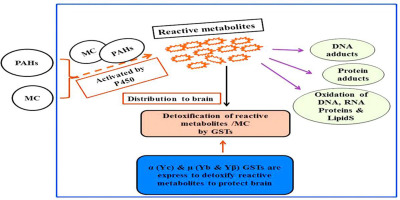Chemico-Biological Interactions ( IF 4.7 ) Pub Date : 2018-08-23 , DOI: 10.1016/j.cbi.2018.08.023 Sreenivasulu Dasari , Muni Swamy Ganjayi , Prabhakar Yellanurkonda , Sreenivasulu Basha , Balaji Meriga

|
Glutathione S-transferases (GSTs), the versatile phase II biotransformation enzymes, metabolize and detoxify a wide variety of toxic chemical compounds like carcinogens, chemotherapeutic drugs, environmental pollutants and oxidative stress products. GSTs are currently of great interest in drug discovery, nanotechnology and biotechnology because of their involvement in many major cellular processes. GSTs, which are either homo or hetero dimeric proteins mediate catalytic binding between glutathione (GSH) and an array of either endogenous or exogenous toxic compounds to form a highly soluble detoxified complex which is then eliminated. Polycyclic aromatic hydrocarbons (PAHs) which are composed of two or more benzene rings bonded as linear, cluster or angular arrangements are used as intermediaries in pharmaceuticals, agricultural products, photographic products, thermosetting plastics, lubricating materials and other chemical products. Foods those cooked at high temperatures by grilling, roasting, frying and smoking are the main sources for the persistent bio-accumulation of PAHs in food chain. The carcinogenic, mutagenic and immunosuppressive effects of PAHs are well established. A well-known polycyclic aromatic hydrocarbon, methylcholanthrene is a potential carcinogenic, neurotoxic, mutagenic and tumour causing agent that is used as an experimental carcinogen in biological research. Methylcholanthrene converts into reactive metabolites when it enters living cells and those reactive metabolites oxidize DNA, RNA, proteins and lipids and form DNA and protein adducts as well. GSTs play major role in the detoxification of reactive metabolites of methylcholanthrene by mediating catalytic binding with GSH to form a highly soluble detoxified complex which is then eliminated. This review summarizes the role of GSTs in the detoxification of a polycyclic aromatic hydrocarbon, methylcholanthrene.
中文翻译:

谷胱甘肽S-转移酶在多环芳烃甲基胆甾醇解毒中的作用
谷胱甘肽S转移酶(GST)是一种多功能的II期生物转化酶,可代谢和解毒多种有毒化合物,例如致癌物,化学治疗药物,环境污染物和氧化应激产物。由于GST参与了许多主要的细胞过程,因此它们在药物发现,纳米技术和生物技术方面引起了极大的兴趣。GST是同源或异源二聚体蛋白,介导谷胱甘肽(GSH)与一系列内源性或外源性有毒化合物之间的催化结合,从而形成一种高度可溶性的解毒复合物,然后将其消除。由两个或多个以线性,簇或角排列方式键合的苯环组成的多环芳烃(PAH)用作药物,农产品,摄影产品,热固性塑料,润滑材料和其他化学产品。通过烧烤,烘烤,油炸和抽烟在高温下烹饪的食物是食物链中PAHs持续生物积累的主要来源。PAHs具有致癌,诱变和免疫抑制作用。众所周知的多环芳烃,甲基胆甾醇是潜在的致癌,神经毒性,诱变和致瘤剂,在生物学研究中用作实验致癌物。甲基胆固醇进入活细胞时会转化为反应性代谢物,而这些反应性代谢物会氧化DNA,RNA,蛋白质和脂质,并形成DNA和蛋白质加合物。GST通过介导与GSH的催化结合形成高可溶性的解毒复合物,从而在甲基胆碱的反应性代谢产物的解毒中起主要作用。这篇综述总结了GST在多环芳烃甲基胆甾醇的解毒中的作用。











































 京公网安备 11010802027423号
京公网安备 11010802027423号